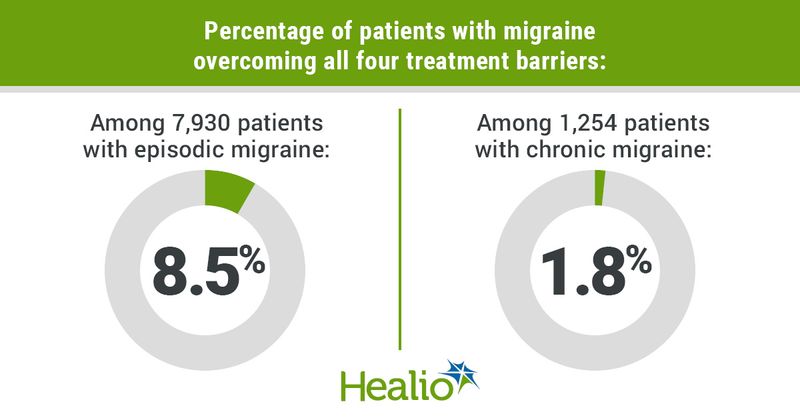CaMEO: Fewer than 10% of patients with migraine overcome treatment barriers
Fewer than 10% of patients with migraine overcome four obstacles “to good medical outcomes” according to results of the Chronic Migraine Epidemiology and Outcomes, or CaMEO, study.
These barriers were a lack of “appropriate medical consultation,” not receiving an “accurate” diagnosis, not receiving acute and preventive therapies and an inability to avoid acute medication overuse, according to the researchers.

“There are more than 1 billion people worldwide with migraine and about 40 million Americans with migraine,” Richard B. Lipton, MD, director of the Montefiore Headache Center and vice chair of the department of neurology at the Albert Einstein College of Medicine, told Healio Primary Care. “Though there have been many breakthroughs in migraine therapy, including drugs, devices and behavioral treatment, there is a wide gap between treatment available and treatment delivered.”
To quantify this gap, the researchers analyzed data from 9,184 patients with migraine (episodic migraine, 7,930; chronic migraine, 1,254) from the CaMEO study who had moderate or severe migraine disability. These patients also met the modified International Classification of Headache Disorders third edition criteria for migraine and had a Migraine Disability Assessment score of two or higher.
The researchers reported that 27.6% (n = 2,187) of the patients with episodic migraine and 40.8% (n = 512) of patients with chronic migraine had an “appropriate headache consultation.” Of these patients, 75.7% (n = 1,655) of the episodic migraine group and 32.8% (n = 168) of the chronic migraine group were accurately diagnosed.
Among the patients with an accurate diagnosis, 59.9% (n = 992) in the episodic migraine group and 54.2% (n = 91) in the chronic migraine group reported receiving minimally appropriate acute and preventive pharmacologic treatment. Among those diagnosed and treated correctly, 31.8% (n = 315) of patients with episodic migraine and 74.7% (n = 68) of patients with chronic migraine met the criteria for acute medication overuse.
In addition, only 8.5% of all 7,930 patients with episodic migraine and 1.8% of all 1,254 patients with chronic migraine overcame all four barriers. Patients with higher incomes had increased rates of overcoming each barrier (P < .05), according to the researchers.

“For people whose lives are disrupted by migraine, traversing all the steps is very helpful,” Lipton said.
Most patients with migraine wait until the last moments of their appointments with primary care physicians to mention their headaches, he said. In such instances, PCPs should schedule a follow-up visit to diagnose and treat the headache disorder.
These visits should “begin with open‐ended questions such as, ‘Tell me about your headaches,’ and ‘How do they affect your life?’” Lipton continued. “Questions often elicit a patient narrative that increases the clinician’s understanding of the patient’s problem and facilitates appropriate diagnosis and treatment.”

